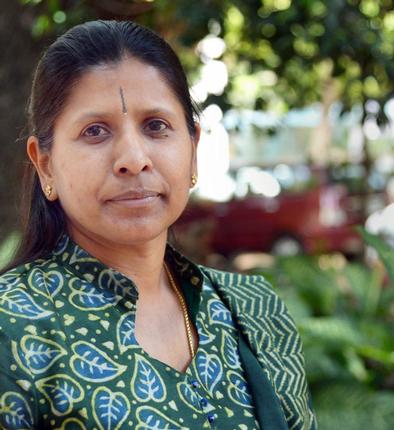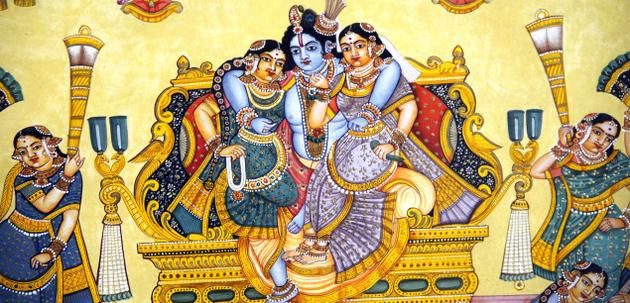
Padhma Priya, who is researching the art of the region, talks to Lalithaa Krishnan about its distinct features.
Describing herself as an amateur artist who grew increasingly interested in the theory and practice of visual art, Padhma Priya allowed her passion for Mysore painting to lead her towards post-graduate studies in Art History from the Chitrakala Parishad, Bengaluru. Her thesis dealt with the ‘Quality of Art Work’. At present, engaged in an extensive research on Mysore paintings, she shares her insights.
What factors contributed to the creation of this distinct pictorial style?
Rooted in the Vijayanagara art tradition, the pictorial vocabulary of the Mysore style was nourished by the versatile talent of migrant artists who worked in different mediums, their intensive, long-drawn training under their gurus and thorough knowledge of Hindu mythology and religious texts helped them compose amazing themes. So, it appears that a deliberate effort has been made by Mysore artists to stand out and create an individualistic style gradually over a period of time.

What are the chief features that distinguish Mysore painting from Thanjavur art?
The differences are evident in terms of methods and materials used. Thanjavur painting is traditionally executed on a jack wood plank with a ground preparation of tamarind seed powder and chalk, while Mysore painting is done on paper. Both schools use jewellery crafted on a flat surface but their techniques differ. Thematically, they share Hindu mythological characters and tales, but my research shows that the Mysore school has a fantastic visual narrative that no other artists of traditional schools have brought forth.
You collaborate with artists, epigraphers and historians. About their valuable inputs…
The foundation for my research is collecting a large, unpublished, unrecorded database across five districts and five taluks of Karnataka. My field work is a rich digital resource database of themes and narratives, artists of Mysore and other arts and crafts of Karnataka. I am grateful to the Karnataka State Archaeology Department, the district administration, Mr. Murari, whose door-to-door survey helped me to locate rare paintings, Mr. Kharbade DG ,NRLC, Lucknow, my art history teachers Dr. R.H. Kulkarni and H.A. Anilkumar of Chitrakala Parishath, Bengaluru, scholars Dr. Jaisree Narasimhan and Dr. Banumathi for deciphering the content of labels and slokas in the paintings, artists K.S. Srihari, Sridhar and R. Sivakumar, who helped document the traditional methods and materials in Mysore paintings.
Which institutions impart formal training in the art? Can artists move beyond creating reproductions and how affordable are Mysore paintings?
The Chitrakala Parishath, Bengaluru, imparts technical training periodically via short-term courses but the need of the hour is to provide long-term training in both theory and technique. Once the artist has a solid grounding in Hindu mythology, iconography and iconology, he can break away from the cliché of mechanical reproduction and create original art works with rare themes. Depending on size, theme and workmanship, prices begin at Rs. 8000 for a 12’’x 15’’ work, to Rs. 200,000 for larger ones.
A note on the conservation of paintings.
I am a quality consultant in fine arts. Through scientific methods, I help buyers check the quality of the art works. Preventive conservation of paintings is my core research. My two-volume publication on the Mysore school is planned for 2017.
Your personal favourites that rank as must-views?
All the paintings in the Mysore palace, Jaganmohan palace and the CKP museum are fantastic collections.
Unusual collection
A connoisseur with a keen eye and memory for detail, art dealer Vitthal Rao brings 40 years of expertise in the field to bear upon the superb collection of Mysore paintings that graces the main gallery, C.P. Arts Centre. Priced between Rs.10,000 and Rs. 40,000, the collation spans myriad deities that include Siva, Vishnu, Kodanda Rama, Krishna, Saraswathi, Lakshmi, Ganesha and Anjaneya and diverse themes such as Pattabhisheka and Rathi-Manmatha. In an unusual portrayal of goddess Tripurasundari, Lord Narayana is shown assuming the form of a bangle seller who fits the ornaments on her hands, as any mere mortal would be burnt by her touch. Varying depictions of a single deity, Chamundeshwari, reflect the vision of different artists. While Yedur Siddhalingeswara, Kalikamba Viswakarma, Tripura Samhara and Dhruva Narayana are rare pieces, the colossal, exquisitely detailed Koteswara Siva and Viswaroopa evoke awe and wonder.
Antique works from royal houses as well as paintings by contemporary artists B.B. Ramakrishna, K.S. Srihari and Dinesh are on display till 18 June. (Timings: 10 am – 8 pm).
source: http://www.thehindu.com / The Hindu / Home> Features> Friday Review> Art / by Lalithaaa Krishnan / June 16th, 2016